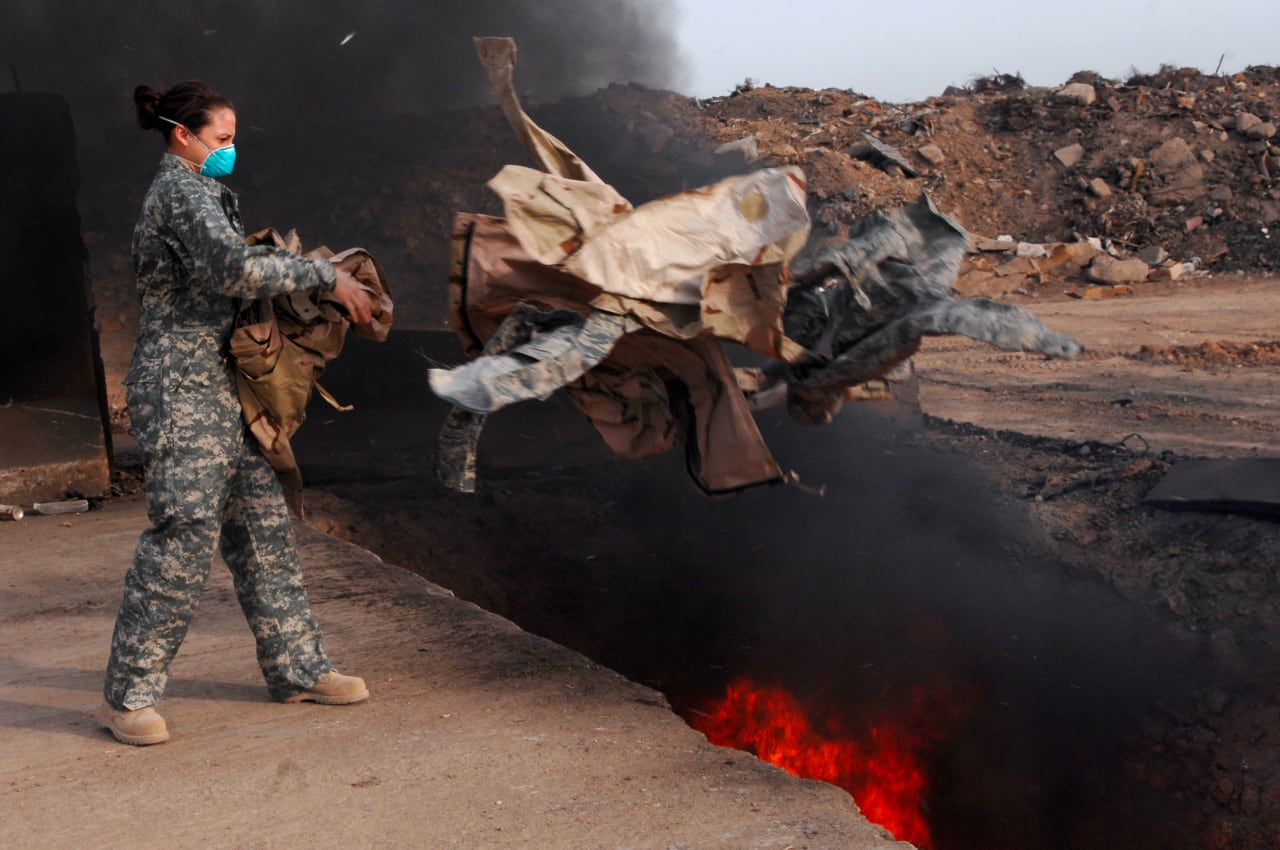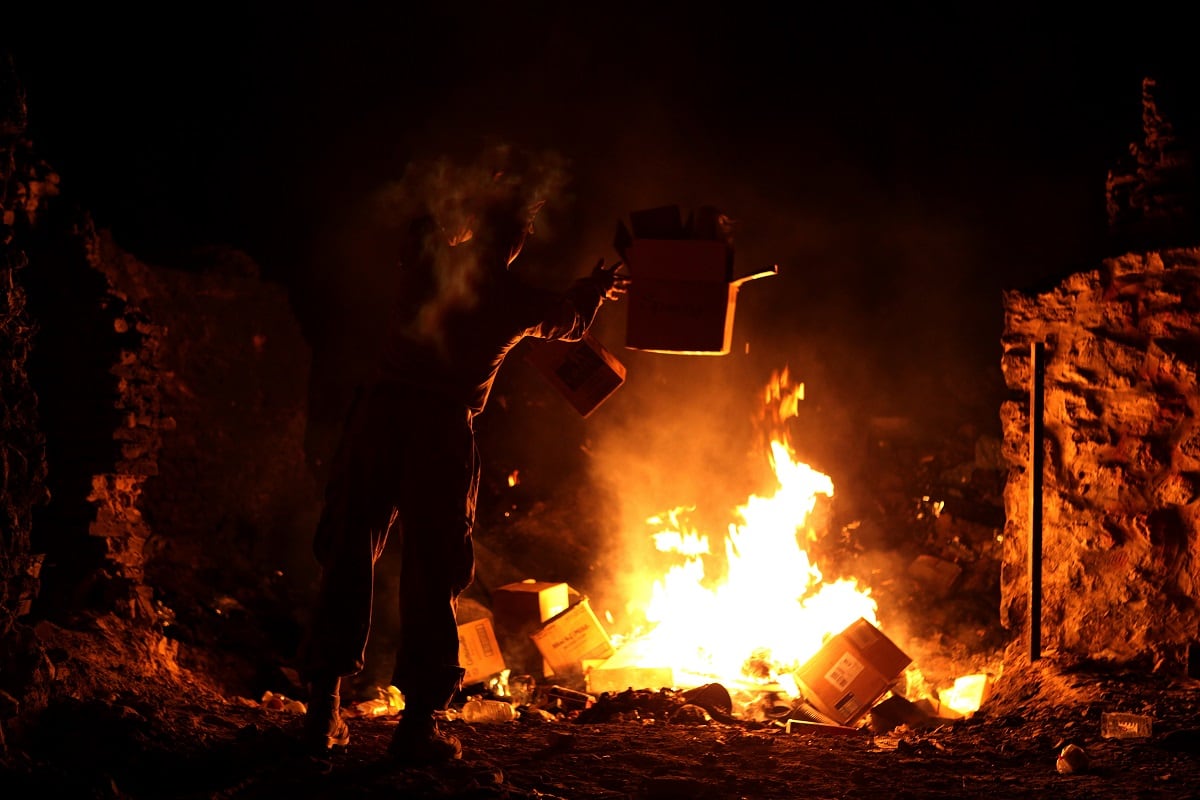EDITOR’S NOTE: In 2008, Military Times reporter Kelly Kennedy published an expansive story looking at thousands of U.S. servicemembers who may have been sickened by the toxic smoke coming out of waste pits at Joint Base Balad in Iraq. The story — the first talking about “burn pit” injuries from overseas war zones — and her subsequent work over the next year has served as the backbone for journalistic work since then looking at toxic exposure injuries from the post-9/11 wars. As the White House and Congress refocus on the issue of burn pit illnesses, Military Times is republishing those early stories to help show what officials knew, what changes have occurred since those early revelations and — perhaps most importantly — what hasn’t changed.
Even as military health officials continue to say there are “no known long-term health effects” caused by open-air burn pits in Iraq and Afghanistan, a team of Army doctors says a soldier’s cystic lung disease is “related to the burn pits in Iraq.”
A second set of doctors, trying to determine why 56 soldiers in the 101st Airborne Division came back from Iraq short of breath, found each had bronchiolitis that could be diagnosed only with a biopsy.
That disease normally comes with organ transplantation, infection, rheumatoid arthritis or toxic fume inhalation. Because there was no scarring on the soldiers’ lungs, doctors decided it must have been toxic inhalation and added a fifth cause of bronchiolitis to their list: “Iraq.”
Since Military Times began reporting in October about burn pits in the war zones, 400 troops have contacted Disabled American Veterans to say they have breathing problems or cancers they believe came after exposure to the burn pits.
Many say they have been diagnosed with “asthma-like” or “allergy-like” symptoms when they’ve complained of shortness of breath, but their doctors can’t come up with an exact diagnosis.
Meanwhile, annual cases of chronic obstructive pulmonary disease among service members have risen 82 percent since 2001, to 24,555 last year, while cases of all other respiratory illnesses have risen 37 percent, to 28,276, Defense Department data show.
A dubious honor
The symptoms cited by service members are remarkably similar. But Spc. Edward Adams, 33, may be the first to have “burn pit” marked in his medical records.
Adams, who joined the Army in 2005, served at Camp Speicher in Tikrit, Iraq, from July 2006 to October 2007, where he lived downwind of a burn pit used to eliminate the base’s waste.
“At night, it was like stepping into a sewer,” he said. “There was a giant black cloud.”
Within months of arriving, he found himself short of breath, felt tightness in his chest and had a constant cough. By the end of his deployment, he couldn’t keep up on physical training runs.
RELATED

“They didn’t treat me at all,” Adams said of medics at the base. “They told me it was dirt and sand. I thought, ‘When I get home, it should clear up.’ But I immediately started getting worse.”
No one seemed able to diagnose his problem, and his X-ray looked clear. Then one night after he came home, his lungs shut down, leaving him unable to breathe.
He spent six days in the hospital and was referred to the pulmonary department. A breathing test showed possible asthma, but that didn’t match other tests.
His doctor, Army Col. Vincent Grbach, ordered an MRI that showed Adams’ lungs were filled with hundreds of tiny black holes—cystic lesions that had spread throughout his lungs.
But unlike the ragged lesions that show up in cases of emphysema, usually in middle-aged smokers, Adams’ lesions were smooth. And there was no scar tissue to show infection.
“The doctors said they hadn’t seen these problems until the last few years,” Adams said. “They asked me if I was near a burn pit.”
Grbach brought up the case at a thoracic conference at Tripler Army Medical Center at Schofield Barracks, Hawaii, where Adams is stationed, to find a diagnosis.
Grbach, who did not respond to e-mail requests for an interview, typed a diagnosis based on the conference in Adams’ file, citing “unanimous agreement” that Adams’ pulmonary disease “represents something other than asthma and is probably related to the burn pits in Iraq.”
Grbach recommended that Adams be medically retired from the military, calling his disease a “chronic lifelong condition.”
In his medical evaluation board, a second doctor determined that Adams’ aorta - the body’s largest blood vessel, leading out from the heart - had decreased in size by about half.
The doctor, Michael McGriff, chief physician of the MEB at Tripler, attributed that to “toxic exposure,” according to Adams’ records, because, again, Adams had no other markers for the problem and no one could figure out what caused it.
“He told me, ‘Get life insurance. We don’t know if you have one year to live or 50,’” said Adams, the father of a 6-month-old boy.
Not an isolated case
Vanderbilt University Medical Center physician Robert Miller said Adams is not the only one coming home from Iraq with breathing problems that are proving difficult to diagnose.
Miller, assistant professor of pulmonary and critical care medicine, was asked by military physicians to see if he could find out why 56 airborne soldiers back from Iraq were short of breath.
RELATED

Their pulmonary function tests came back normal, and their X-rays and MRIs showed nothing out of the ordinary.
But only one had had a baseline pulmonary function test before deploying. That test checks how much air a person’s lungs can hold, usually by seeing how much he can blow out or inhale.
That soldier scored 115 percent of normal on a pre-deployment test. Post-deployment, he tested at 80 percent. By itself, 80 percent is not considered abnormal—but a 35-point drop is “a huge change,” Miller said.
Miller and his research partner, Matthew King, began asking soldiers if they had been exposed to anything in Iraq. Most had been exposed to sulfur dioxide from a sulfur mine fire in Mosul in 2003. The others had been exposed to open burn pits.
Miller biopsied the soldiers’ lungs. In each of the 40 soldiers he tested, he found bronchiolitis, an obstruction of the lungs’ tiniest airways—including in those soldiers who had not been exposed to the sulfur mine.
The disease should have shown up on the soldiers’ X-rays, but it didn’t. Miler called that “very unusual.”
As more soldiers came in over the years, Miller ordered a lung biopsy on every one who had shortness of breath—not normal procedure for that condition.
“At first, I didn’t biopsy them,” he said. “But two of my most severe patients had chest X-rays that were completely normal.”
One, a former marathon runner who had continued to run while in Iraq, was so debilitated upon her return in 2005 that she is now on oxygen. She had not been exposed to the sulfur mine fire, even though Miller said sulfur dioxide is “the most significant toxin for this lesion.”
What else could produce sulfur dioxide? In a memo dated Dec. 20, 2006, Air Force Lt. Col. Darrin Curtis, former bioenvironmental flight commander for Joint Base Balad, Iraq, which at one time burned 250 tons of trash a day, cited sulfur dioxide as a byproduct of the burn pit.
Miller’s patients probably will have breathing problems for the rest of their lives.
He recommends the military require baseline pulmonary function tests for all active-duty service members so there is something to compare with later, if necessary.
Ultimately, Miller said, the military needs to take a serious look at its practice of long-term, open-pit burning of trash. “I believe it’s inhalational exposure,” he said of the patients he has seen and continues to see. “I’m concerned about what’s out there.”





